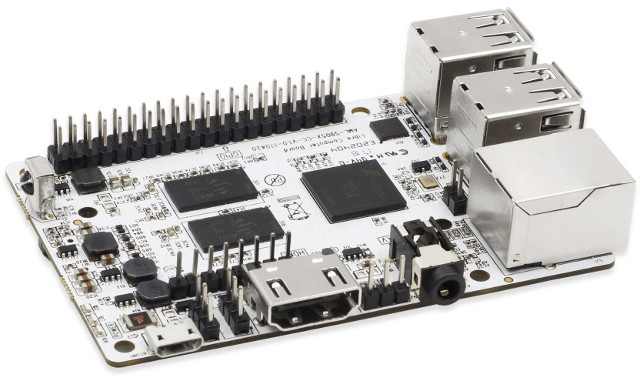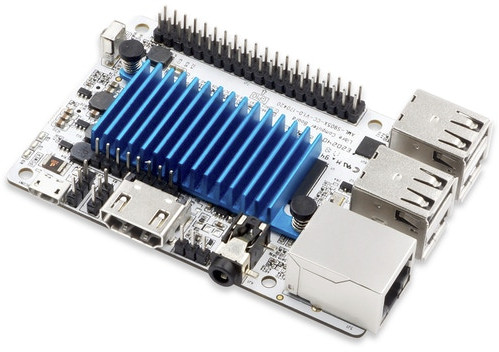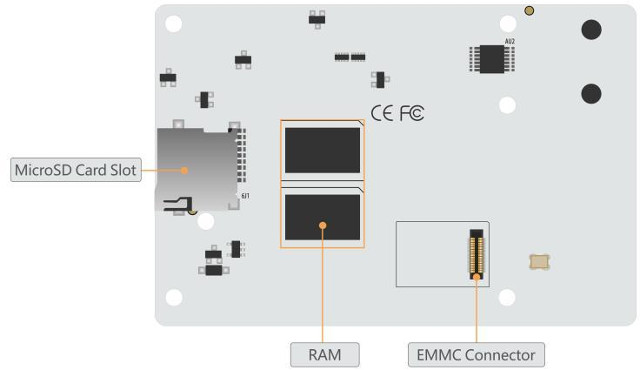Up to now there were two notable Amlogic S905(X) development boards: ODROID-C2 and Khadas Vim. Shenzhen Libre Technology Co., Ltd, a Shenzhen startup, is about to bring one more to the market with Le Potato board, aka AML-S905X-CC, powered by Amlogic S905X processor with 1 or 2 GB RAM, and in a form factor similar to the Raspberry Pi 3 board.
 Le Potato /AML-S905X-CC board specifications:
Le Potato /AML-S905X-CC board specifications:
- SoC – Amlogic S905X quad core ARM Cortex-A53 processor @ 1.5 GHz with penta core ARM Mali-450MP GPU, and Amlogic Video Engine 10
- System Memory – 1GB or 2GB DDR3 RAM
- Storage – 1x micro SD Card slot with UHS SDR104 support, eMMC module connector with HS400 support
- Video Output – HDMI 2.0 Port, 3.5mm TRRS “AV” jack with CVBS (480i / 576i)
- Audio Output – HDMI, AV jack (stereo audio), SPDIF output header, and I2S header
- Connectivity – 10/100M Ethernet
- USB – 4x USB 2.0 host ports
- Expansion
- ADC + I2S Header
- 40-pin Raspberry Pi header with I2C, SPI, PWM, 5V, 3.3V, and GPIO
- Debugging – UART via header for access to the serial console
- Misc – IR Receiver, onboard jumper for HDMI CEC or GPIO 11 selection, status LEDs,
- Power Supply – 5V via micro USB port
- Dimensions – Raspberry Pi 3 form factor
An optional heatsink will also be available for the board, and included in the kits, but not the cheaper rewards.
The company expects some level of upstream support for the board in Linux 4.13, with Linux 4.9 & 3.14 buildroots also available, and the Android 7.1 SDK from Amlogic. Debian and Ubuntu LTS Linux distributions will be officially supported, and you’ll be able to “easily package your own distributions as well.”
A short explanation about the “Libre” part in the company and project name was also provided:
Le Potato will have basic upstream support in Linux 4.13 and we will push for full support of the feature set of the board including the media components in upstream Linux. We will disclose as much as legally possible with regards to the design to help facilitate development of this platform and add-ons to this platform.
The board has launched on Kickstarter with a $25,000 funding target, and a 37 minutes video (not a typo) showing an overview of the board, as well as various demos. A $25 pledge should get you the board with 1GB RAM, which you’d need to up to $35 if 2GB is better suited to your project(s) or use case(s). Shipping adds $7 to the US, and $13/$14 to Europe, with other countries unavailable, and delivery scheduled for August 2017, right after the campaign ends.
 A pretty detailed comparison between the board and competitors like Pine64+, Raspberry Pi 3 and Asus Tinkerboard is also provided on the crowdfunding page, and I found it to be fair, and the company clearly knows what they are talking about. Le Potato is the first board of the Libre Computer project, and if you look on the project website, a Rockchip RK3328 board – called Le Fly / ROC-RK3328-CC – should also be in the works. I had never heard about Shenzhen Libre Technology company before, but the Kickstarter page has been setup by Da Xue, who also happens to manage LoveRPi, a US distributor and reseller of electronic boards and accessories. [Update: I’ve been informed that LoveRPi is just managing the campaign, and is not directly related to the manufacturer]
A pretty detailed comparison between the board and competitors like Pine64+, Raspberry Pi 3 and Asus Tinkerboard is also provided on the crowdfunding page, and I found it to be fair, and the company clearly knows what they are talking about. Le Potato is the first board of the Libre Computer project, and if you look on the project website, a Rockchip RK3328 board – called Le Fly / ROC-RK3328-CC – should also be in the works. I had never heard about Shenzhen Libre Technology company before, but the Kickstarter page has been setup by Da Xue, who also happens to manage LoveRPi, a US distributor and reseller of electronic boards and accessories. [Update: I’ve been informed that LoveRPi is just managing the campaign, and is not directly related to the manufacturer]

Jean-Luc started CNX Software in 2010 as a part-time endeavor, before quitting his job as a software engineering manager, and starting to write daily news, and reviews full time later in 2011.
Support CNX Software! Donate via cryptocurrencies, become a Patron on Patreon, or purchase goods on Amazon or Aliexpress





I think the Khadas Vim is a better deal and a more complete package. They’ve also very responsive and easy to get in touch with on their forums. I don’t really see this new board bringing anything new – other than a catchier name 🙂 I’ve got to say though, mainline Linux support is an empty promise… I got the Khadas thinking support would be just around the corner and it seems development has completely stalled. Neil Armstrong made the OpenGL Mesa drivers, but USB support is lacking and the whole thing seems to be pretty half baked 🙁 Here’s… Read more »
I fail to understand why some companies start a kickstarter campaign to build boards which already exist (odroid-c2, khadas vim, nanopi-k2). I can easily understand that well established companies want to build their own boards when their processes make this a trivial task, but going through a full campaign tells me that it’s still a tough work for them, and the final result *if it works* might just be to steal a few market shares from vendors already doing a nice work, neither improving on the design nor showing a significant price reduction. Innovation seems to be missing these days.… Read more »
They are a little late on the game with the rock64 around the corner, and Khadas announced they will introduce a new board in July. And before tkaiser can jump on it, it’s powered through micro usb, so they didn’t really check the community before designing the board. The only thing I think is positive is that those emmc modules will probably get cheaper if more boards start to use them.
@geokon They are paying for mainline support. It is summer holiday in France. @Willy Different target market. They already have working boards. IMHO, more competition is better. Firefly had a RK3399 prototype in RPi form factor. The power consumption is as insane as the Tinkerboard and basically throttled itself to hell. Forget about putting one of those in cases. You can always get a Qualcomm 835 board but those will run you $300 at mass production which will never happen because of the price. @roel Le Fly is mildly suggestive as a Rock64 competitor. The board consumes around 1A which… Read more »
@lvrp16
According me now competition the rock64 has usb3 and gig ethetnet. Depends for what you want to use it. 1A is a little low if you ad a externa hdd and wifi stick. But as I said it depends from the case of use. Although do for sure it doesnt make the board more expensive. And for once, forget those RPI buyers, because they could use their micro usb psu.
It’s nice to see more boards and open manufacturers, so huge kudos to Shenzhen Libre Technology for not pulling a SinoVoip. But I won’t buy this. Why: MicroUSB power and 10/100 Ethernet. Why put such a powerful SoC and then ruin the design with such choices? The price is good, but not fantastic. Maybe their “Le Fly” board will be better, let’s see. Right now my wallet waits for ROCK64. roel : And for once, forget those RPI buyers, because they could use their micro usb psu. Raspberry Pi also has lots of problems with poor quality cables/power supplies. Just… Read more »
@Mum
They have not released anything yet, so wait and see.
S905X only supports 10/100M, no option for Gigabit Ethernet, unless USB to GbE is considered to be an option…
@lvrp16 Micro USB on Tinkerboard is just bizarre but since RK3288 with TinkerOS is able to reach 1.7A peak consumption while booting without external peripherals inserted users realize it rather fast that something is wrong (but unfortunately not what’s wrong — they think about buying larger power bricks instead of being aware about the whole situation: most probably the USB cable between power brick and PSU is also insufficient as it’s the case with +99% of all USB cables out there since they’re all just designed with 500mA max in mind!) More generally speaking: Micro USB might be ok when… Read more »
@lvrp16 For me personally ‘Micro USB powered only’ is both a ‘don’t buy’ and also a ‘never ever provide community support‘ criteria. Take Armbian as an example: instead of doing something useful with our time we have to discuss the same silly and boring support questions over and over again. Especially since users don’t get why ‘new SBC’ doesn’t work while with same PSU and cable their RPi standing next to it does (simple reason: RPi Foundation is evil). I hope other devs will agree and we finally implement this but I think Armbian needs a simple ‘refuse to boot’… Read more »
@tkaiser
Most of the people that want to work with a rpi don’t know anything about electricity, volt and ampère is chinees for them. I’m volunteer in a project to assist people working with a rpi and in fact you have to learn them first about volt, ampére and all those crappy cables, connectors and hubs.
The Potato! Who comes up with these names?
Comments from their own tests ” Since we got our boards back from manufacturing, we have been hammering at it in our labs with tests and benchmarks. The benchmark numbers above can provide a rough estimate of the performance numbers we expect to see. All of the benchmark numbers were done in a controlled environment in a case with a 20mm 5V fan. While the Raspberry Pi 3 Model B and our board ran consistently without a fan, the ASUS Tinker Board created a lot of heat and required a fan to get consistent numbers. The ASUS Tinkerboard maxed out… Read more »
The heatsink is not mounted correctly on the picture. 🙂
@roel Yes, exactly that’s the problem. The average user being encouraged to do something wrong which they’re not able to understand at the same time. Micro USB + electrical engineer –> no problem Micro USB + device needing less than 500 mA –> also no problem Micro USB + average user + higher power demands –> problem Electrical engineer not understanding average users –> big problem Engineers not considering what will happen outside of their lab away from bench PSUs and appropriate cabling is the real mess. Exactly how SinoVoip explains why it’s a great idea selling a Micro USB… Read more »
@tkaiser
I’d be curious to see what USB-C will do to these boards. To be properly compliant cables have to have a maximum of 0.5v voltage drop at 5V (not sure how that compares to micro USB). As an added bonus we can draw up to 3A, with PD if you need more for say a heavily loaded tinkerboard or 16 x A73 cores.
@CampGareth USB-C with ‘dev boards’ will most probably be the same sh*t show as with Micro USB now since board vendors use the type-C connector without following specs (simple rule: never buy anything featuring a USB-C connector missing the appropriate logos) and then adapter cables and converters already exist (Aliexpress –> ‘usb-c type a’) so average users will still fail trying to use inappropriate phone or smart chargers or even crappy USB cables combined with a ‘Micro USB to USB-C adapter’ for $0.3. Only when almost all chargers are equipped with USB-C any more (able to provide at least 1.5A… Read more »
@Björn I fear the heatsink is mounted correctly covering a very large rather irrelevant area but the S905X only partially. We know about S905 heat dissipation since used on ODROID-C2, there the heatsink is much larger both wrt area and fin heights and the SoC is at the center of the heatsink. This heatsink works fairly well but if you cramp the board in a tiny enclosure and put heavy load on both CPU and GPU cores it will overheat and start to throttle. And based on the picture above I expect this to happen here somewhat earlier (especially when… Read more »
In the 37 min video they show the power consumption while running Geekbench 4: pretty low consumption but total score only 1154. That needs some explanation given ODROID-C2 and Khadas Vim score between 1600 and 1700 😉
@tkaiser
The board scored 660 and 1900 on geekbench which is higher than both of those boards. You are looking at the renderscript score.
@lvrp16
Where did you hear that? :))
And paid by who?
I remember reading it’s a volunteer effort on their behalf
Hope you’re right and it’s a matter of just waiting a bit longer
@tkaiser They think a micro usb connection is common and easy to explain what is needed because everybody has one for their smartphone. But for example the barrel connector used on the cubie’s and the opi’s is compatible with a psu from a sony psp (1st generation, I don’t follow these things). So you can find it also everywhere. It’s just a matter how to sell it. If you say a barrel connector of 3.5/1.35 of course nobody knows and are scared to buy it. But if you say you can use a psu from a sony psp, people know… Read more »
roel : It’s just a matter how to sell it. Exactly. For a board maker Micro USB makes a lot of sense since they think about customer’s decision processes. The potential customer compares 2 SBC for $25 each. One needs an external PSU listed for an additional $8, the other is equipped with ‘universal Micro USB’ to be used with crappy phone chargers lying around anyway. So the average user chooses the more expensive variant: Micro USB. He pays $25 + shipping for the board, spends some time with instability issues, buys then a new power brick for $10 (+… Read more »
guess how many PayPal refund claims i got after selling no-more-needed Orange Pi’s
@George Kontsevich
Amlogic contracted Bay Libre for Linux upstreaming work.
Check the comments @ http://www.cnx-software.com/2017/03/06/mainline-linux-on-64-bit-arm-amlogic-socs-and-tv-boxes-such-as-wetek-hub-player-2-nexbox-a1-a95x-etc/
@lvrp16
Thank you for pointing this out. I’ve to admit I lack the patience to really watch this video 🙂
@Jean-Luc Aufranc (CNXSoft)
Well… there is one comment that says
”
kszaq
March 7th, 2017 at 04:12 | #2
Reply | Quote
AFAIK BayLibre have been hired by Amlogic to work on mainlining the latest Mesons.
”
Sounds like hearsay 😛
Haven’t seen anything definitive. Hope you’re right though
Welcome another new member for the SBCs dev community 🙂
@George Kontsevich
For all the other boards, it was a volunteer effort.
@geokon
Not heresay.
Or even better idea – screw terminals and proper cable with USB A on the other end.
@Jean-Luc Aufranc (CNXSoft)
In the kickstarter gallery there are new pictures from the board with heatsink.
@tkaiser
Sure have CPU / GPU areas that do not need a heatsink directly.
This heatsink was so designed to cover the CPU / GPU / RAM and was therefore mounted incorrectly!
Compare old and new picture::
No, really no comparison with ODROID-C2, there is no note about ODROID at crowdfunding page. They compare with RPI3, Asus Tinkerboard and PINE64 boards.